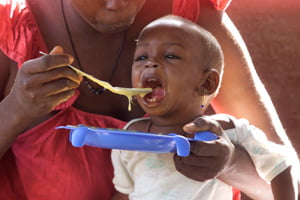Ed note. This post, by Dr. Ramadhani Abdallah Noor, originally appeared in Project Syndicate and is reprinted with permission.
DAR ES SALAAM – Just over 20 years ago, South African photographer Kevin Carter shocked the world with a controversial photograph of a famished young Sudanese child being watched by a vulture during a famine. Critics slammed the shot as “disaster porn,” calling it yet another example of how the international media sensationalize African problems.
But what disturbs me is not the photograph. Rather, it is that two decades later, the conditions that the photograph depicts remain basically the same. Every year, 3.1 million children around the world still die of hunger.
As an African doctor, I know that the ravages of serious malnutrition and hunger are not always visible. They are not always as manifest as they are in the protruding ribs of ghostly children hooked up to feeding tubes, like those I used to see in hospital wards in Tanzania. Chronic malnutrition, or “hidden hunger,” shows itself in other ways – but it can be just as devastating and deadly. And while deaths from many other diseases, including acute malnutrition, have declined, hidden hunger remains pervasive.
In the last two decades, astounding success has been achieved in the fight against HIV, tuberculosis, and malaria. New HIV infections have dropped by as much as 50% in some countries in Africa, with AIDS-related deaths down by 30-48%; TB cases have declined by 40%, and malaria cases by 30%.
But the stunting of early childhood growth as a result of malnutrition remains high, dropping by only about 1% over the same period. In Africa, hunger remains the leading cause of death in children, accounting for half of all deaths of children under the age of five and killing more than AIDS, TB, and malaria combined.
In fact, many scientific studies have shown that a malnourished child is much more likely to contract an infection, to suffer from other illnesses, and to suffer from them longer. Diarrhea, for example, is a deadly disease for severely underweight children, who are 12 times more likely to die from an ailment that should be easily treated. And severely underweight children are 9.5 times more likely to die from malaria as well.
Indeed, childhood malnutrition is now confirmed to be the leading cause of the global disease burden, with the World Health Organization attributing to it 45% of all deaths under the age of five in 2011. Recent reports from the war-ravaged Central African Republic indicate that more children there are dying from hunger than from bullets.
These numbers make the problem of malnutrition look insurmountable. But what works is no secret: vitamin A, iodized salt, and fortified foods. The lack of vitamin A alone results in blindness in a half-million children every year, with half of them dying within 12 months of losing their sight. Similarly, half of all women of childbearing age in developing countries suffer from weakened immune systems, owing to anemia caused by iron deficiency.
The long-term damage caused by malnutrition has a domino effect, impeding educational achievement, and ultimately, hobbling national economies. Addressing this ongoing crisis requires money – an estimated $10 billion per year – and new and better strategies to bring life-saving solutions to the mothers and children who most need them.
But the cost looks far less daunting when one considers the cost of hunger. UNICEF estimates that the cost of Africa’s child malnutrition is $25 billion a year. And this is not the whole story. Malnutrition costs an estimated $3.5 trillion every year to the global economy, owing to loss of productivity and higher health-care costs.
To meet this challenge, save lives, and improve economies, Africa needs a comprehensive strategy and increased investment in agriculture.
The Africa Union has declared 2014 the year of agriculture and food security in Africa, and the continent’s agriculture sector is expected to grow significantly. In theory, that should improve overall nutrition; but increased investment in agriculture is not a panacea. We need to concentrate on building nutrition-sensitive agriculture programs that include small-scale farmers, households, women, and children.
A big step would be to increase women’s control over land ownership and farming decisions, along with access to agricultural credits and subsidies designed to encourage domestic food production through home gardening and cattle and poultry husbandry. Studies show that women are much more likely than men to spend additional income on food and health. Increasing their farming income and decision-making power ultimately has a greater impact on children’s health and nutrition.
Moreover, agricultural policies, subsidies, and investments have traditionally benefited cereal farmers. But policymakers need to concentrate on increasing access to more nutritious foods, such as meat, fruit, and vegetables, which are too expensive for the poor.
Malnutrition causes the greatest damage during the first thousand days of life, leading to grievous and irreversible changes in infant health. To make real inroads against hidden hunger, African governments, supported by global development partners, must act quickly. Childhood hunger in Africa does not have to be as dramatic as that depicted in Carter’s 1993 photograph to be just as deadly.
Ramadhani Abdallah Noor, a Tanzanian doctor and research associate at the Harvard School of Public Health, is a New Voices Fellow at the Aspen Institute
